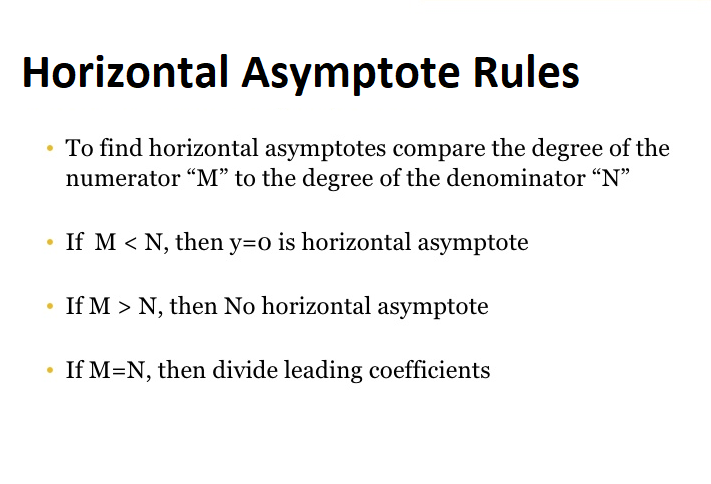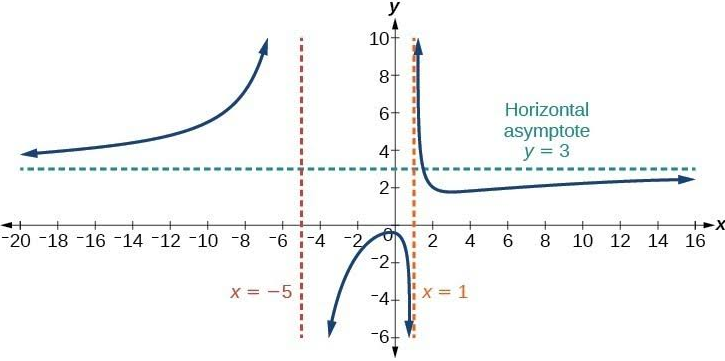Table of Contents
Horizontal Asymptotes – Before getting into the definition of a horizontal asymptote, let’s first go over what a function is. A function is an equation that tells you how two things relate. Usually, functions tell you how y is related to x. Functions are often graphed to provide a visual. A horizontal asymptote is a horizontal line that tells you how the function will behave at the very edges of a graph. A horizontal asymptote is not sacred ground, however. The function can touch and even cross over the asymptote. Horizontal asymptotes exist for functions where both the numerator and denominator are polynomials. These functions are called rational expressions.
Let’s look at one to see what a horizontal asymptote looks like. So, our function is a fraction of two polynomials. Our horizontal asymptote is y = 0. Look at how the function’s graph gets closer and closer to that line as it approaches the ends of the graph. We can plot some points to see how they function behaves at the very far ends. Do you see how the function gets closer and closer to the line y = 0 at the very far edges? This is how a function behaves around its horizontal asymptote if it has one. Not all rational expressions have horizontal asymptotes. Let’s talk about the rules of horizontal asymptotes now to see in what cases a horizontal asymptote will exist and how it will behave.
Horizontal Asymptotes Rules
There are three rules that horizontal asymptotes follow depending on the degree of the polynomials involved in the rational expression. Before we begin, let’s define our function like this:
 Our function has a polynomial of degree n on top and a polynomial of degree m on the bottom. Our horizontal asymptote rules are based on these degrees.
Our function has a polynomial of degree n on top and a polynomial of degree m on the bottom. Our horizontal asymptote rules are based on these degrees.

When n is less than m, the horizontal asymptote is y = 0 or the x-axis.
When n is equal to m, then the horizontal asymptote is equal to y = a/b.
When n is greater than m, there is no horizontal asymptote.
The degrees of the polynomials in the function determine whether there is a horizontal asymptote and where it will be. Let’s see how we can use these rules to figure out horizontal asymptotes.
Horizontal Asymptote Degree Rules
Horizontal Asymptote Degree
A horizontal asymptote is a horizontal line that tells you how the function will behave at the very edges of a graph. A horizontal asymptote is not sacred ground, however. The function can touch and even cross over the asymptote.
Horizontal asymptotes exist for functions where both the numerator and denominator are polynomials. These functions are called rational expressions. Let’s look at one to see what a horizontal asymptote looks like.

So, our function is a fraction of two polynomials. Our horizontal asymptote is y = 0. Look at how the function’s graph gets closer and closer to that line as it approaches the ends of the graph. We can plot some points to see how they function behaves at the very far ends.
x, y
-10,000 ,-0.0004
-1000, -0.004
-100, -0.04
-10, -0.4
-1, -4
1, 4
10, 0.4
100, 0.04
1000, 0.004
10,000, 0.0004
Do you see how the function gets closer and closer to the line y = 0 at the very far edges? This is how a function behaves around its horizontal asymptote if it has one. Not all rational expressions have horizontal asymptotes. Let’s talk about the rules of horizontal asymptotes now to see in what cases a horizontal asymptote will exist and how it will behave.

Horizontal Asymptote Examples
f(x)=4*x^2-5*x / x^2-2*x+1
First, we must compare the degrees of the polynomials. Both the numerator and denominator are 2nd-degree polynomials. Since they are the same degree, we must divide the coefficients of the highest terms.
In the numerator, the coefficient of the highest term is 4.
In the denominator, the coefficient of the highest term is understood 1.
4/1=4
The horizontal asymptote is at y = 4.
f(x)=x^2-9 / x+10
First, we must compare the degrees of the polynomials. The numerator contains the 2nd-degree polynomial while the denominator contains the 1st-degree polynomial.
Since the polynomial in the numerator is a higher degree than the denominator, there is no horizontal asymptote. There is a slant asymptote instead.
Can a function have more than one horizontal asymptote?
The answer is no, a function cannot have more than two horizontal asymptotes.
Why can graphs cross horizontal asymptotes?
The graph crosses the x-axis at x=0. For x> 0, it rises to a maximum value and then decreases toward y= 0 as x goes to infinity. For x< 0, it decreases to a minimum value then rises toward y= 0 as x goes to negative infinity. y= 0 is a horizontal asymptote but the graph crosses y= 0 at x= 0.
How do you find vertical and horizontal asymptotes?
The vertical asymptotes will occur at those values of x for which the denominator is equal to zero: x − 1=0 x = 1 Thus, the graph will have a vertical asymptote at x = 1. To find the horizontal asymptote, we note that the degree of the numerator is two and the degree of the denominator is one.
Can a graph cross a horizontal asymptote?
NOTE: A common mistake that students make is to think that a graph cannot cross a slant or horizontal asymptote. … A graph CAN cross slant and horizontal asymptotes (sometimes more than once). It’s those vertical asymptote critters that a graph cannot cross. This is because these are the bad spots in the domain.
How do you find the asymptote of an equation?
Vertical asymptotes can be found by solving the equation n(x) = 0 where n(x) is the denominator of the function ( note: this only applies if the numerator t(x) is not zero for the same x value). The graph has a vertical asymptote with the equation x = 1.
Which function has no horizontal asymptote?
A rational function has no horizontal asymptote when the degree of the numerator is greater than the denominator. A) f(x)=2x-1/3x^2, the degree of the numerator is lower than the denominator. B) f(x)=x-1/3x, the degree of the numerator is lower than the denominator.
How do you find the vertical asymptote of a function?
To find the vertical asymptote(s) of a rational function, simply set the denominator equal to 0 and solve for x.
What is a horizontal asymptote in exponential functions?
An asymptote may be vertical, oblique or horizontal. Horizontal asymptotes correspond to the value the curve approaches as x gets very large or very small. exponential function: Any function in which an independent variable is in the form of an exponent; they are the inverse functions of logarithms.
